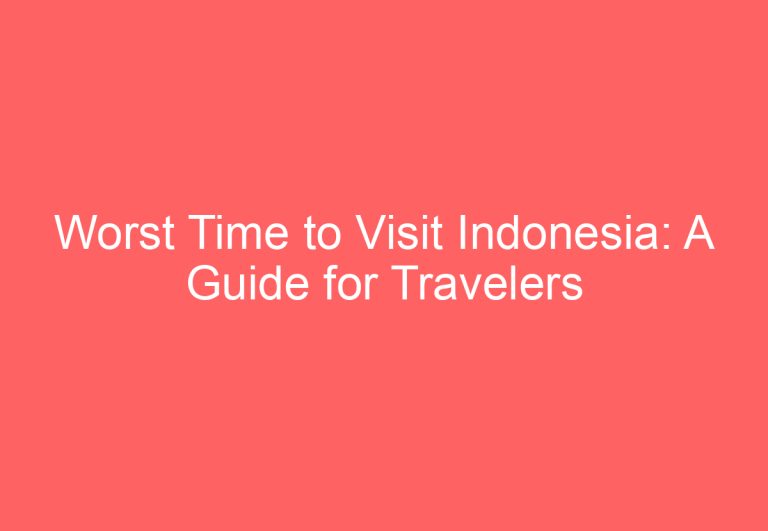Worst Time to Visit Phoenix: A Guide to Avoiding the Heat and Crowds
Phoenix, Arizona is a popular tourist destination, but not all times of the year are ideal for a visit. While the city has plenty to offer, including beautiful natural landscapes, cultural attractions, and a vibrant food scene, there are certain times of the year when visitors may want to think twice before planning a trip.

When it comes to the worst time to visit Phoenix, the answer is simple: summer. From June through August, the city experiences its highest temperatures, often exceeding 100°F. This intense heat can be challenging for outdoor activities and exploration, potentially leading to discomfort and health risks like heat exhaustion.
While summer may be the worst time to visit Phoenix, there are plenty of other times of the year that are more pleasant. Visitors may want to consider planning a trip in the fall, winter, or spring, when temperatures are more moderate and the city is bustling with events and activities. By planning a trip during the right season, visitors can make the most of their time in Phoenix and enjoy all that the city has to offer.
Challenging Weather Conditions

When it comes to challenging weather conditions, Phoenix has a few that visitors should be aware of. From extreme summer heat to monsoon season and winter crowds, there are a few factors that can make traveling to Phoenix difficult during certain times of the year.
Extreme Summer Heat
Phoenix is known for its hot temperatures, especially during the summer months of June, July, and August. During this time, the temperatures can reach well above 100°F, making it uncomfortable to be outside for extended periods of time. Visitors should take precautions to avoid heat exhaustion and heat stroke by drinking plenty of water, wearing sunscreen, and seeking shade when possible. It’s also important to note that the dry heat can be deceiving, and visitors may not feel the effects of the heat until it’s too late.
Monsoon Season and Humidity
While the summer months bring extreme heat, they also bring monsoon season and increased humidity. From mid-June to the end of September, Phoenix experiences monsoon season, which can bring sudden and heavy rainstorms, strong winds, and lightning. The humidity during this time can make the heat feel even more intense, and visitors should be prepared for sudden weather changes.
Winter Crowds and Events
While winter may seem like a more comfortable time to visit Phoenix, it also brings crowds and events. From December to March, Phoenix experiences an influx of visitors, especially during the holiday season and major events like the Waste Management Phoenix Open golf tournament and spring training for Major League Baseball. This can make it difficult to find accommodations and tickets to events, and visitors should plan accordingly.
Overall, while Phoenix offers a lot to see and do, visitors should be aware of the challenging weather conditions that can make traveling difficult during certain times of the year. By taking precautions and planning accordingly, visitors can still enjoy all that Phoenix has to offer.
Travel Considerations

When planning a trip to Phoenix, it is important to consider several factors to ensure a smooth and enjoyable experience. This section will provide information on accommodation and rates, transportation and accessibility, as well as local attractions and activities.
Accommodation and Rates
Phoenix offers a wide range of accommodation options, from budget-friendly motels to luxury resorts. However, it is important to note that rates can vary greatly depending on the time of year. The peak tourist season in Phoenix is from November to April, which is also when hotel rates tend to be the highest. Visitors looking to save money on accommodation may want to consider visiting during the summer months, when rates are typically lower.
Transportation and Accessibility
Getting around Phoenix is relatively easy, with several transportation options available. Visitors can rent a car, take a bus or train, or use ride-sharing services. However, it is important to note that traffic can be heavy during rush hour, so visitors should plan accordingly. Additionally, some attractions may not be easily accessible by public transportation, so visitors may want to consider renting a car.
Local Attractions and Activities
Phoenix has a variety of attractions and activities to suit every interest. Outdoor enthusiasts can explore South Mountain Park or go on a hiking or biking adventure. Golfers can play a round at one of the many world-class golf courses in the area. Culture-seekers can visit museums such as the Musical Instrument Museum or take a stroll through the Desert Botanical Garden. Families with children may want to visit the Phoenix Zoo or go on a Wild West adventure at Rawhide Western Town.
Overall, visitors to Phoenix should consider the time of year they plan to visit, their transportation needs, and the attractions and activities they wish to experience when planning their trip. By taking these factors into account, visitors can ensure a memorable and enjoyable trip to the Valley of the Sun.
Frequently Asked Questions

What are the peak heat months to avoid in Phoenix?
Phoenix is known for its hot and dry climate, with temperatures that can soar well above 100 degrees Fahrenheit. The peak heat months in Phoenix are typically June through August. During these months, the heat can be oppressive and make outdoor activities uncomfortable, if not dangerous. Visitors should take precautions to stay hydrated and avoid being outside during the hottest parts of the day.
Which season is considered the least comfortable for tourists in Phoenix?
While the summer months are the hottest in Phoenix, the monsoon season, which runs from mid-June through September, can also be uncomfortable for tourists. The humidity can make the already high temperatures feel even hotter, and the frequent thunderstorms can disrupt outdoor activities.
During what months does Phoenix experience the most extreme temperatures?
Phoenix experiences its most extreme temperatures during the summer months, typically from June through August. During this time, temperatures can reach well above 100 degrees Fahrenheit, and visitors should take precautions to stay cool and hydrated.
What times of year is Phoenix known for having poor air quality?
Phoenix is known for having poor air quality during the summer months, when high temperatures and stagnant air can trap pollutants close to the ground. Visitors with respiratory issues may want to take extra precautions during this time.
When does Phoenix typically have its highest visitor congestion?
Phoenix typically experiences its highest visitor congestion during the winter months, from December through February. Many visitors come to Phoenix during this time to escape colder weather in other parts of the country and enjoy the mild temperatures and sunny skies.
What part of the year should travelers avoid if they want to escape the desert heat in Phoenix?
Travelers who want to escape the desert heat in Phoenix should avoid visiting during the summer months, from June through August. Instead, they may want to consider visiting during the winter or spring, when temperatures are milder and more comfortable for outdoor activities.



![Worst Time To Visit Yellowstone [Never Visit in THIS TIME]](https://howtravelplan.com/wp-content/uploads/2024/05/worst-time-to-visit-yellowstone-never-visit-in-this-time_3082-768x531.jpg)
![Worst Time To Visit Atlanta [Never Visit in THIS TIME]](https://howtravelplan.com/wp-content/uploads/2024/05/worst-time-to-visit-atlanta-never-visit-in-this-time_3169-768x531.jpg)
![Worst Time To Visit Bangkok [Never Visit in THIS TIME]](https://howtravelplan.com/wp-content/uploads/2024/05/worst-time-to-visit-bangkok-never-visit-in-this-time_3144-768x531.jpg)
![Worst Time To Visit New York [Never Visit in THIS TIME]](https://howtravelplan.com/wp-content/uploads/2024/05/worst-time-to-visit-new-york-never-visit-in-this-time_3097-768x531.jpg)